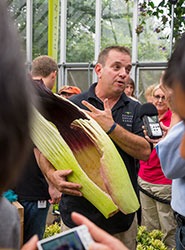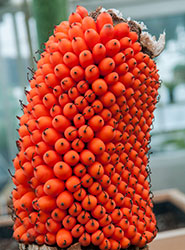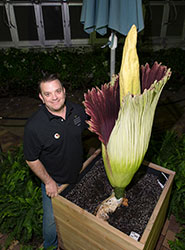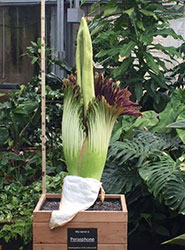
Spike 3.0
Third time's the charm
Spike the corpse flower has bloomed again at the Chicago Botanic Garden. This is the third time Spike has begun a bloom cycle. In 2015, the corpse flower ultimately lacked the energy to bloom. In 2018, at nearly 7 feet tall, Spike finally bloomed, smelling like rotting meat or flesh. Spike nailed it again on the third go-around.

Behind the scenes, in the staff-only production greenhouses, our experts will hand pollinate Spike with pollen gathered from two corpse flowers that recently bloomed, Hope and The Velvet Queen. Blooming is not the end of the life cycle for these plants, which are also known as titan arums. When pollinated, they produce fruit and then store up energy until ready to bloom again. The Garden began collecting titan arums in 2003, as part of a worldwide conservation effort to preserve the rare species.
The corpse flower, or titan arum (Amorphophallus titanum), is native to the rainforests of Indonesia. In bloom, it is known for its size, stench, and beauty—look for the deep crimson color of the frilly spathe, or modified leaf, around the tall central spike.
Spike was our first corpse flower to begin its bloom cycle in August 2015. More than 75,000 people came to the Garden to see Spike, and more than 300,000 people around the world watched the plant’s progress on live webcam. But the notoriously fickle plant got stuck in pre-bloom mode.
Where has Spike been since then?
We moved the plant to our production greenhouse and repotted Spike’s corm, which is a beach ball-sized underground tuber. Ever since then, Spike has been collecting energy from the sun to begin the bloom cycle again.
Didn’t you just have a titan arum bloom?
Yes; a corpse flower named Hope recently bloomed, as well as our "three-headed monster"—The Velvet Queen, which had three flowering spikes from a single corm. The Garden began collecting titan arums in 2003, as part of a worldwide conservation effort to preserve the species. Many of our titans were acquired at the same time, which is why the Garden has had several ready to bloom in a short time period.
Spike 3.0 Growth Chart
| Date | Height | Girth |
| 5/8 | Broke soil surface | |
| 5/11 | 5" | 8.25 |
| 5/12 | 5.25" | 9 |
| 5/13 | 6.125" | 9.875 |
| 5/14 | 7.5" | 11 |
| 5/15 | 9" | 12.25 |
| 5/16 | 10.5" | 13.5 |
| 5/17 | 12.75" | 14.25 |
| 5/18 | 14.25" | 14.625 |
| 5/19 | 16.125" | 15.625 |
| 5/20 | 18" | 16.375 |
| 5/21 | 20.125" | 17.25 |
| 5/22 | 22.75" | 18.5 |
| 5/23 | 25.875" | 20.375 |
| 5/24 | 28.25" | 21.75 |
| 5/25 | 31.125" | 23.75 |
| 5/26 | 34" | 24.5 |
| 5/27 | 37" | 26.75 |
| 5/28 | 39.625" | 27.75 |
| 5/29 | 44" | 30.625 |
| 5/30 | 50.25" | 34.625 |
| 6/1 | 58.25" | 39 |
| 6/2 | 64.25" | 41.25 |
| 6/3 | 68.625 | 43.375 |
| 6/4 | 71.875" | 45.25 |
| 6/5 | 74.5" | 47 |
| 6/6 both bracts fell, spathe showing red | 77.5" | 48 |
| 6/7 | 79.625" | 50.375 |
| 6/8 | 80.5" | 51 |
Spike 2.0 Growth Chart
| Date: | Height: |
| 4/25/2018 5 p.m. | SPIKE BLOOMS! 82.0" |
| 4/24/2018 | 82.0" |
| 4/23/2018 | 79.5" |
| 4/22/2018 | 76.5" |
| 4/21/2018 | 73.5" |
| 4/20/2018 | 70.25" |
| 4/19/2018 | 66.5" |
| 4/18/2018 | 62.5" |
| 4/17/2018 | 59.0" |
| 4/16/2018 | 54.25" |
| 4/15/2018 | 50.75" |
| 4/14/2018 | 47.5" |
| 4/13/2018 | 44.0" |
The Garden’s Corpse Flower Family

Spike was the Garden’s first corpse flower to begin its bloom cycle in August 2015. Spike ultimately lacked the energy to open—showing us just how unpredictable these plants are.

Alice the Amorphophallus bloomed in September 2015. Both Spike and Alice came to the Garden from the University of California, Berkeley, in 2003.

Sprout bloomed in April 2016. Sprout was germinated from a seed that was sent to the Garden from the University of California, Berkeley, in 2008.

Persephone was given to Garfield Park Conservatory and bloomed there in June 2016. This titan arum also was grown from seed sent to us in 2008 from UC Berkeley.

Java and Sumatra bloomed in succession on May 30 and June 1, 2017.

Sunshine bloomed on August 20, 2017. This was our first titan arum to bloom outside the greenhouse environment.


